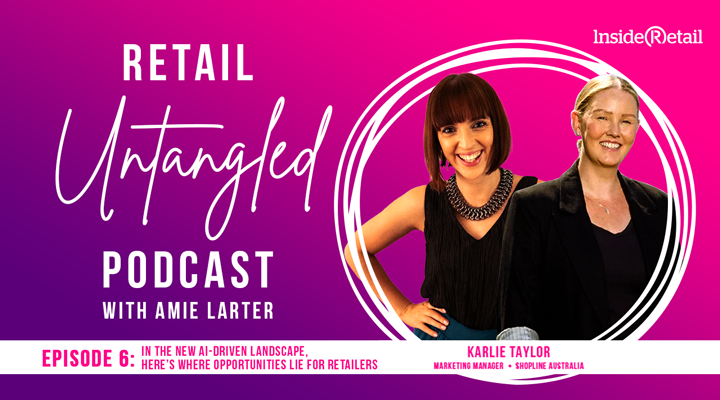Artificial Intelligence (AI) has evolved from just a concept to many into a tangible, essential tool for businesses to improve engagement and optimise efficiency. And retail is predicted to be one of – if not the biggest – industry investor in AI technology moving forward.
Where do the true opportunities for retailers lie in this AI-driven landscape – and is it still the domain of trailblazers or is it a tool every business should now be embracing or risk being left behind?
Amie Larter of Inside Retail talked with Karlie Taylor, marketing manager at unified commerce platform Shopline, for this month’s Retail Untangled podcast series.
She hopes AI will lead to more conversations between retailers and customers – and a higher average order value.
“In a nutshell, it’s about personalisation, which is what marketing and advertising has always been about. How can we personalise better? How can we get our messages read and responded to? AI is really going to help that, especially in the retail sense.
“It will enable retailers to understand their customers better and give them better customer experiences,” Taylor told Larter.
From a holistic point of view, she explains, the technology will enable the differentiated one-to-one experiences that retailers have been talking about for so long.
“That’s where retail is really going to see the benefits. It’s about bringing the data together to create these hyper-personalised experiences. It really feels like in 2023, we’ve moved from talking about AI to very much using it in one way or another.”
But not all Australian retailers have embraced this technology, she says. “I think some are a little bit scared, looking to see what other markets are doing.”
A good example of successful AI implementation by a retailer is online marketplace The Iconic – a company Taylor has always considered as being at the forefront of embracing new technologies – which famously created an app that used augmented reality to allow customers to ‘try on’ shoes online.
Taylor describes The Iconic’s AI-driven personalisation engine as “amazing”, giving customers the ability to search through products and be served up with items they are actually looking for.
Another brand she cites is online sizing tool Fit Finder, which uses generative AI to understand customers’ size and fit requirements, learning from why people return purchases and updating the data in real time to offer a better customer experience.
Other applications Taylor identifies where AI can play a pivotal role for retailers include inventory management (using data forecasting to identify trends and avoid overordering), refining advertising content and placement online to boost conversions and using ChatGPT to develop marketing content better suited to targeted audiences.
But with any AI application, Taylor stresses, its success will depend on the integrity of the data it is fed.
With a marketing application, for example, you need accurate data from website hits, of how people are interacting with your blog posts, social media interactions, emails and other communications – and then you should use AI to filter that to create copy that cuts through to your unique audience, she says.
As an example, she cites the personalisation on Asos’ website. “Aussie brands need to keep up. They need to ensure that they have the data there and they’re personalising the customer experience because customers have so many choices these days – if they don’t like what you are selling, they can go to someone else. And chances are it’s a similar product at a similar price point.”
So what is the roadblock stopping Australian retailers from using AI – is it mindset or hesitancy on how to implement it from a business perspective, Larter asks.
“Again, it comes down to data,” says Taylor. “I see a lot of big retailers that have these big monolithic systems, that cannot integrate the different data points… who no matter what they do, they cannot get a single source of truth.
“Then I see some of the smaller, up-and-coming retailers who have access to less sophisticated technology, but they’re doing it really well because they might not have hundreds of millions of followers, but they know everything about them because everything is linked to one system. They know how to speak to them, they know what’s on each customer’s wishlist. So they can serve them unique messages using these data points.
“If the data is bad, you’re not going to get the cut through. For example, if you are targeting me with a product for a retiree, that’s not me. But if you’re targeting me with something for children aged five to 10, it is absolutely going to get cut through and I’m highly likely to purchase that product.”
Also in the Retail Untangled podcast, Taylor talks about how AI can help retailers be more sustainable by predicting trends and customer demand for products – thus reducing the volume of products that will go to waste through low demand, offers advice on how retailers can go about starting their AI journey and addresses the elephant in the room: what impact will it have on jobs.






